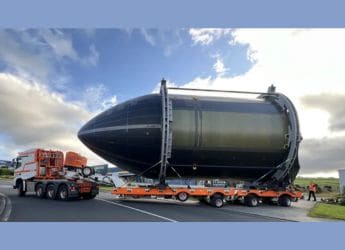- Home
- Science
- Science News
- Blue Origin’s New Shepard NS 29 Conducts First Lunar Gravity Simulation
Blue Origin’s New Shepard NS-29 Conducts First Lunar Gravity Simulation
Blue Origin’s NS-29 mission simulated Moon gravity to support lunar research, with key experiments funded by NASA.

Photo Credit: Blue Origin
The New Shepard rocket lifted off from the company’s West Texas facility on February 4 at 11 a.m
A significant milestone in suborbital spaceflight was achieved by Blue Origin with the launch of its uncrewed NS-29 mission. The New Shepard rocket lifted off from the company's West Texas facility on February 4 at 11 a.m. EST, following a week-long delay caused by adverse weather conditions and a technical issue in the rocket's avionics system. The booster and capsule both returned to Earth successfully, though one of the capsule's three parachutes did not fully deploy. Blue Origin stated during the live broadcast that the capsule was engineered to land safely with fewer than three parachutes.
Lunar Gravity Simulated for Research Payloads
According to reports, the NS-29 mission introduced a lunar gravity simulation for the first time using the New Shepard vehicle. The capsule achieved this by rotating approximately 11 times per minute for a duration of two minutes, a manoeuvre facilitated by its reaction-control thrusters. The mission carried 30 research payloads, with 29 focused on lunar-related technologies. Blue Origin outlined six key research areas, including in-situ resource utilisation, dust mitigation, advanced habitation systems, sensors and instrumentation, small spacecraft technologies, and entry, descent, and landing systems.
NASA-Supported Research Aboard the Flight
More than half of the payloads were backed by NASA's Flight Opportunities Program. The U.S. space agency is engaged in efforts to establish a long-term human presence on and around the Moon through the Artemis programme. A NASA experiment named the Electrostatic Dust Lofting project examined how lunar dust becomes electrically charged and lifted under ultraviolet light exposure. Another NASA-supported study, the Lunar-g Combustion Investigation, explored fire behaviour under the Moon's gravity conditions to enhance safety measures for future lunar habitats.
Future Applications of Gravity Simulation
In an X(formerly Twitter) post, Blue Origin Chief Executive Officer Dave Limp stated that this capability provides NASA and other lunar technology developers with a cost-effective method to conduct research. He added that New Shepard's gravity simulation could be adapted for Mars and other celestial bodies, expanding its potential for future space exploration research.
Get your daily dose of tech news, reviews, and insights, in under 80 characters on Gadgets 360 Turbo. Connect with fellow tech lovers on our Forum. Follow us on X, Facebook, WhatsApp, Threads and Google News for instant updates. Catch all the action on our YouTube channel.
Related Stories
- Samsung Galaxy Unpacked 2025
- ChatGPT
- Redmi Note 14 Pro+
- iPhone 16
- Apple Vision Pro
- Oneplus 12
- OnePlus Nord CE 3 Lite 5G
- iPhone 13
- Xiaomi 14 Pro
- Oppo Find N3
- Tecno Spark Go (2023)
- Realme V30
- Best Phones Under 25000
- Samsung Galaxy S24 Series
- Cryptocurrency
- iQoo 12
- Samsung Galaxy S24 Ultra
- Giottus
- Samsung Galaxy Z Flip 5
- Apple 'Scary Fast'
- Housefull 5
- GoPro Hero 12 Black Review
- Invincible Season 2
- JioGlass
- HD Ready TV
- Laptop Under 50000
- Smartwatch Under 10000
- Latest Mobile Phones
- Compare Phones
- Redmi Note 15 5G
- Redmi Note 15 Pro 5G
- Redmi Note 15 Pro+ 5G
- Lava Play Max
- Poco C85 5G
- Honor Magic 8 Lite
- Jolla Phone
- Realme P4x 5G
- Asus ProArt P16
- MacBook Pro 14-inch (M5, 2025)
- OnePlus Pad Go 2
- Poco Pad M1
- Just Corseca Skywatch Pro
- Honor Watch X5
- Acerpure Nitro Z Series 100-inch QLED TV
- Samsung 43 Inch LED Ultra HD (4K) Smart TV (UA43UE81AFULXL)
- Asus ROG Ally
- Nintendo Switch Lite
- Haier 1.6 Ton 5 Star Inverter Split AC (HSU19G-MZAID5BN-INV)
- Haier 1.6 Ton 5 Star Inverter Split AC (HSU19G-MZAIM5BN-INV)

















